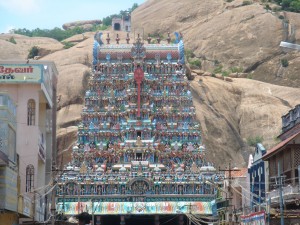Thirupparamkunram Murugan Temple, one of the Arupadaiveedu, the six main abodes of Lord Muruga, the temple at Tiruparankunram offers a mystic beauty. It is carved in rock and is monstrous in size for such architecture. According to fable it is where Lord Muruga married Deivayanai, the divine daughter of the king of heaven, Indra, and he is said to have worshipped Shiva here as Parangirinathar.
The temple is located 8 kilometres (5.0 mi) from Madurai in India. In the main shrine, apart from Muruga, deities of Lord Shiva, Lord Vishnu, Lord Vinayaka and Goddess Durga are housed. The other Arupadaiveedu’s dedicated for Lord Muruga are Thiruchendur (100 km south of Madurai), Palani (120 km west of Madurai), Swamimalai (150 km east of Madurai), Thiruthani (50 km from Chennai) and Pazhamudircholai (10 km north of Madurai).
History
There are several architectural features of interest, particularly the rock cut portion of this hill temple dating back to the Pandya period and the life sized sculpture in the mandapams of the Nayakar period. An Aasthaana Mandapam with several artistically carved pillars lead one to the towering 150 feet (46 m) high Rajagopuram at the entrance.
The Kambathadi Mandapam, Ardha Mandapam, and Mahamandapam are situated at different levels. The main shrine is an early rock cut temple which has cells that house the sanctums of Subramanya, Durga, Vinayakar, Shiva and Vishnu. All the statues are carved on the wall of the parankundram rock. The presiding deity lord shiva is known Parangirinathar and the female deity his consort mother Parvathy is known as Aavudai Nayaki. Panels depicting Shiva’s dance of bliss are seen outside the sanctum. These magnificent works of art date back to the Pandya period.
In front of the Dwajasthambam or the Kodi Maram, one gets the magnificently carved Nandi, Mayil and the Mouse (the vehicle of Lord Ganesha). This is a specialty of this Murugan shrine. Going inside; one can see the sannidhis of different Hindu Gods and Hindu Goddesses. Of special mention is the sannidhi of Saneeswaran without the other eight Grahas. Climbing a flight of six steps called the “Shadashara Padigal”, one reach the Ardha Mandapam. One gets to see the rock carvings of Mahisshasura Mardini, Karpaga Vinayagar, Andarabaranar and Uggirar.
There is also a rock engraved sannidhi for Lord Vishnu and Goddess Lakshmi. Shiva in the form Sivalingam and Sathiyagireeshwarar sannidhis located here cannot miss the notice of the Muruga Bakthas visiting this Murugan shrine.
The Moolavar deity is also sculptured from a rock. Abhishekams for the presiding deity is done to the Murugan’s Vel only. There are five Theerthams, or divine water source, in and around the temple, Saravana Poigai, Lakshmi Theertham, Saniyasi Kinaru (well), Kasi Sunai, and Sathiya Koopam. The Pandya rulers particularly could be credited with a large number of these cave temples but for want of a more definite classification, historians club all these jointly under the common term, Pallava style even though these temples are in the heart of the Pandya country where no Pallava ever set foot.
Many of the big and small temples around Madurai in Tamilnadu and the Muruga temple at Tirupparankundram are popular. Situated almost on the outskirts, only 7 kms away from Madurai, Tirupparankundram, Parankundram, as it was known in the olden days, has been a place of pilgrims throng to the shrine of Muruga (Subramanya) in their huge number, but hardly one of these devout souls pays attention to the beauty of the temple or the construction of the sanctum.
From the beautiful Asthana Mandapam on the main front facing the street, which figures in every tourist’s photograph collection, one climbs, through two higher mandapams to the Sanctum of Subramanya, where one is lost in the holiness of it and hardly notices anything else. Actually, the shrine is a large rectangular chamber excavated into the huge main rock. There can be no doubt about its age and there are many inscriptions, which speak of repairs and renovation refer to this shrine in the early days. Other insciptions refer to the founding of a few more shrines at the place.
From these evidences, we could see that the shrine of Murugha should have existed prior to the eighth century A.D. It is probably very much earlier as it is mentioned in the Agananuru and other Sangam works and in the Thevaram. All these works refer to the place as Parankundram. The Paripadal (about the 6th century A.D.) gives a very graphic account of the route from Madurai to Tirupparankundram when the Pandya king visited the place in state. The Poem describes in minute details, the many shrines, mandapams and painted chambers not omit even the monkeys which were as plentiful then as they are even to this day.
This rock-cut Pandya sanctum follows the usual plan of many such edifices with two chambers on either side or reliefs on the facing wall. In the chamber on the west is a Linga with the characteristic Somaskanda panel on the back wall as in many early Pallava shrines. The Chamber on the eastern side has a relief of Vishnu and on the wall facing the entrance is a figure of Durga inside a shrine chamber. On either side of this are the figures of Subramanya and Ganesha respectively.
Tirupparankundram is only 7kms from Madurai connected by an excellent road. Frequent buses and vans function to the place. Taxi or auto may be hired from Madurai. It is best to stay at Madurai where very good lodges are available.




